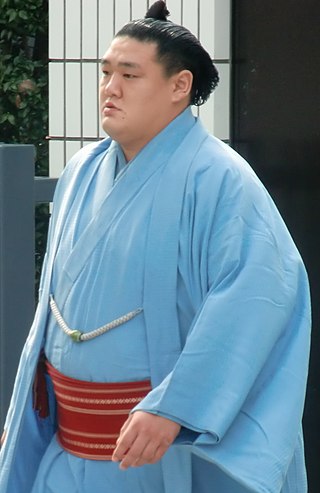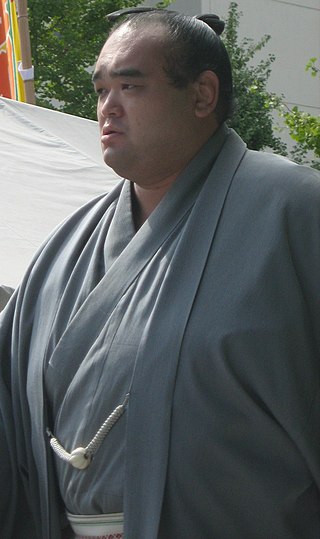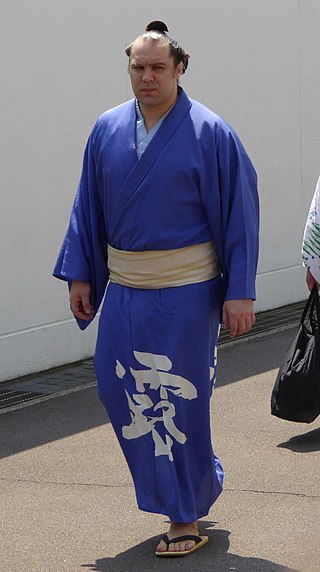Shunketsu Yūji is a former sumo wrestler from Misato, Saitama, Japan. The highest rank he reached was maegashira 12.

Tosanoumi Toshio, is a former sumo wrestler. He first reached the top division of professional sumo in 1995, winning 13 special prizes and earning 11 kinboshi or gold stars for defeating yokozuna over his long career. The highest rank he reached was sekiwake. He retired in 2010 to become a coach at his stable, Isenoumi stable under the name of Tatekawa.

Tamanoshima Arata is a former sumo wrestler from Izumizaki, Fukushima, Japan. A former amateur champion, he made his professional debut in 1998, reaching the top makuuchi division at the end of 2000. He was twice runner-up in a tournament, and earned six special prizes and two gold stars during his career. His highest rank was sekiwake. He wrestled for Kataonami stable. He retired in November 2011 to become an elder of the Japan Sumo Association and is now known as Hanaregoma Oyakata. In December 2021 he became head coach of Hanaregoma stable.

Satoyama Kōsaku is a retired professional sumo wrestler from Ōshima, Kagoshima Prefecture, Japan. A former amateur sumo champion at Nihon University, he entered professional sumo in 2004 and first reached the top makuuchi division in 2007. His highest rank was maegashira 12. He spent much of his career in the jūryō and makushita divisions, and won a yusho or tournament championship in each. He won promotion back to the top division in 2014 after a seven-year and 37-tournament absence, the longest ever. He was a member of Onoe stable. He retired in November 2018 and is an elder of the Japan Sumo Association under the name of Chiganoura.

Hōchiyama Kōkan is a former sumo wrestler from Hirosaki, Aomori Prefecture, Japan. He joined professional sumo in 2000. His highest rank was maegashira 14, achieved in 2006. After illness saw him demoted to the third makushita division in 2008, he returned to the second highest jūryō division in 2010 and the top makuuchi division in September 2011. After winning the sandanme division he had just been demoted to in November 2013, he chose to retire. He is now a coach at Sakaigawa stable under the name of Tatsutagawa (立田川).

Jūmonji Tomokazu is a former sumo wrestler from Aomori, Japan. Joining the professional ranks in 1992, he reached the top division in 2000 and was ranked there for 34 tournaments until 2007. His highest rank was maegashira 6. He was forced to retire in April 2011 after an investigation by the Japan Sumo Association found him guilty of match-fixing.

Shimotori Norio is a former sumo wrestler from Arai, Niigata Prefecture, Japan. A former amateur champion, he made his professional debut in 2000 and first reached the top division in 2002, although due to injuries he had trouble maintaining that position. He earned one special prize, for Fighting Spirit. His highest rank was komusubi. He was forced to retire in April 2011 after an investigation by the Japan Sumo Association found him guilty of match-fixing.

Ryūhō Masayoshi is a former sumo wrestler from Nakagami, Okinawa, Japan. His highest rank was maegashira 16.

Hamanishiki Tatsurō is a former sumo wrestler from Kumamoto, Japan. A former amateur champion, he made his professional debut in 1999. His highest rank was maegashira 11, which he reached in 2002. He was mostly ranked in the makushita and sandanme divisions from 2005 until his retirement in 2012. He became an elder of the Japan Sumo Association upon his retirement and was the head coach of the Kasugayama stable from 2012 until 2016.

Tamaasuka Daisuke is a former sumo wrestler from Atsuta-ku, Nagoya, Aichi Prefecture, Japan. He made his professional debut in March 1998. His highest rank was maegashira 9. He was well known for moving between the top makuuchi division and the second jūryō division on several occasions. He won two makushita and two jūryō division championships. He retired in September 2016 and is now a sumo coach.

Bushūyama Takashi is a Japanese former sumo wrestler from Aomori, Aomori Prefecture. He made his professional debut in January 1999. At the age of 32, he was promoted to the top makuuchi division in the November 2008 tournament. His highest rank was maegashira 3. He is now a sumo coach.

Shōtenrō Taishi is a former sumo wrestler from Khovd Province, Mongolia. He joined professional sumo in 2001 and was known as Musashiryū Taishi until 2007. He made the top makuuchi division for the first time in 2009 and his highest rank was maegashira 2. He wrestled for Fujishima stable. He acquired Japanese citizenship in 2017 and retired shortly before the January 2018 tournament to become an elder of the Japan Sumo Association. As of June 2022 he is known as Nishikijima Oyakata.

Mōkonami Sakae is a former sumo wrestler from Mongolia. After making his professional sumo debut in March 2001, he had his top makuuchi division debut 8 years later in July 2009. His highest rank was maegashira 6. He has acquired Japanese citizenship. In April 2011 he was ordered to retire by the Japan Sumo Association after an investigation found him guilty of match-fixing.
Hamanoshima Keishi is a former sumo wrestler from Uto, Kumamoto Prefecture, Japan. A former amateur champion, he turned professional in 1992, reaching the top makuuchi division in 1994. His highest rank was komusubi. After his retirement from active competition in 2004 he became an elder of the Japan Sumo Association and founded Onoe stable in 2006, which has produced a number of top division wrestlers.

Sōkokurai Eikichi is a former professional sumo wrestler from Inner Mongolia, China. He is the only Chinese national to reach the top makuuchi division. Sōkokurai is of Mongolian descent. He made his professional debut in 2003 and was promoted to the top division in September, 2010.

Fujiazuma Kazuyoshi is a Japanese professional sumo wrestler from Adachi, Tokyo, Japan. He entered sumo in March 2003, reaching the top makuuchi division in July 2011. His highest rank to date has been maegashira 4, which he achieved in July 2013 after he put together five straight kachi-koshi or winning records in the top division. He was last ranked in makuuchi in 2015 and since then has been in the jūryō and makushita divisions. He wrestles for Tamanoi stable.
Tamaryū Daizō is a former sumo wrestler from Nagasaki, Japan. He made his debut in 1970, retiring in 1992. He was one of the lighter sekitori wrestlers. His highest rank was komusubi. He was a member of Kataonami stable.

Amūru Mitsuhiro is a former professional sumo wrestler from Lesozavodsk, Primorsky Krai, Russia. After an initial influx of Russian wrestlers from the early 2000s, he was the last ethnic Russian in top level sumo. He made his debut in May 2002 and, after a serious knee injury in 2012 sent him down the rankings, reached the top makuuchi division in November 2014. His highest rank was maegashira 5. He had nine tournaments ranked in the top division, but finished his career in the third highest makushita division.

Daiamami Genki is a Japanese professional sumo wrestler from Tatsugō, Kagoshima. After a successful amateur career, he turned professional in January 2016, making the top makuuchi division in November of the following year. His highest rank has been maegashira 11. He wrestles for Oitekaze stable.

Meisei Chikara is a Japanese professional sumo wrestler from Setouchi, Kagoshima. He debuted in sumo wrestling in July 2011 and made his makuuchi debut in July 2018. His highest rank has been sekiwake. He wrestles for Tatsunami stable. Unusually for a top-class sumo wrestler, he uses his given name as his shikona.

















